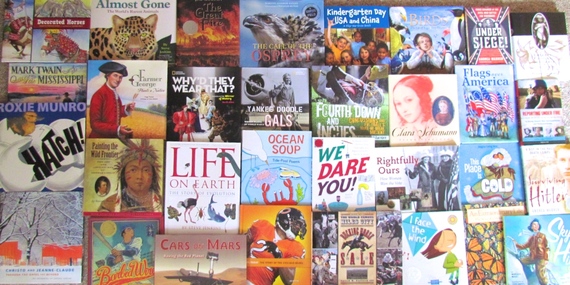In my last post, where I posited that high-quality trade books, like those in the picture, have a hard time getting into classrooms, several people challenged me: Where did I get my information? That's a fair question. As an author of nonfiction books, I understand it is my responsibility to give sources for my information. The short answer is I have no hard evidence. I'm being anecdotal as are many of the people who commented on the post. Everyone who read that post cares deeply about education. Some of you teach in excellent schools where you are free to select the materials that are taught. So you can claim from your standpoint that I don't know what I'm talking about. I have spent the last week or so looking for some hard evidence to back up my claim. Let me tell you how I know and what I've learned.
When I signed a contract with Pearson to license them the rights to three paragraphs from one of my books for a standardized test, it was written that 4 million children would be reading the excerpt. Four million! In contrast, I have royalty statements for sales of my books. Do you know that the average first printing for a children's nonfiction trade book is 7,500 copies? It's hard to get initial print run information from publishers. They don't like to tell us authors how much they believe/don't believe in our books by letting us know how many they plan on selling. But after being in this business for more than forty years, I've gotten a few numbers. If you sell 25,000 copies of a hard cover, that's a successful book. If you sell 100,000 copies of a mass market paperback (like many Scholastic books), that's a successful book. Now think of how many textbooks sell in a state adoption by Texas, where a book must be purchased for every fourth grader in the state, and the books are big, heavy (read expensive) tomes. (As for sales numbers, think the millions who will be reading my excerpt on the standardized tests) We're talking apples and oranges here folks, when it comes to trade vs textbooks sales. We trade book authors are happy if each school bought one copy for their library.
So I called a market research firm to see if I could get some numbers of text books sales vs tradebook sales but apparently those numbers have to be gleaned from overall sales and they haven't been able to break out those figures. I'll let you know when I find out.
I wrote to Megan Schliesman of the Cooperative Children's Book Center in Madison to see if she could spread any light on the issue Here's what she said:
That's a tough one, and something I can comment on only anecdotally. I think that yes, there are districts where literature-based learning is the norm. But what I also see--and I see it here in Madison--is intense pressure to raise test scores AND close the achievement gap, and so districts are looking for, not easy solutions, but solutions that they hope will genuinely garner better results and often include "packaged" components, leveled reading options, etc. (When in my opinion what will garner better results is more support for teaching and learning with funding being a critical component. It just kills me that we see school budgets get smaller while more and more criticism aimed at them.)
And when we add in Common Core I think there is both more room for great opportunity--the ELA standards themselves speak to critical thinking/critical literacy with an increased emphasis on non-fiction across the learning day--and pressure to implement that, again, makes packaging appealing. (My own feelings about CC are that the standards themselves aren't an issue, but how they are implemented and assessed make all the difference.)
Aside from trying to find hard data from sales figures, I can only rely on my extensive experience as an author who has done school visits in 49 of the 50 states (absent, North Dakota). The schools that invite an author to visit as part of an enrichment program are already self-selected as better schools. Most of the time I've been informed that I am the first nonfiction author they've invited. The most important thing I can do at these visits is be entertaining. They hire me for my nightclub-act performance, not because of a learning outcome on the part of students. Only once, in my career, was I invited to a school to see how much children learned as a result of using my books. I will write about that in my next post.
So, absent hard data, we have rely on our gut experiences and collective anecdotes. Just today, esteemed education historian, Diane Ravitch, said, "Big data can't take the place of a caring teacher."
There are times in life when we have to live with our instincts and gut feelings and no hard evidence. (Sigh!)

